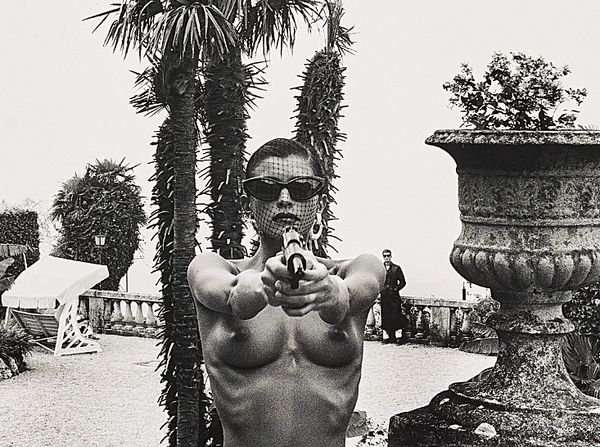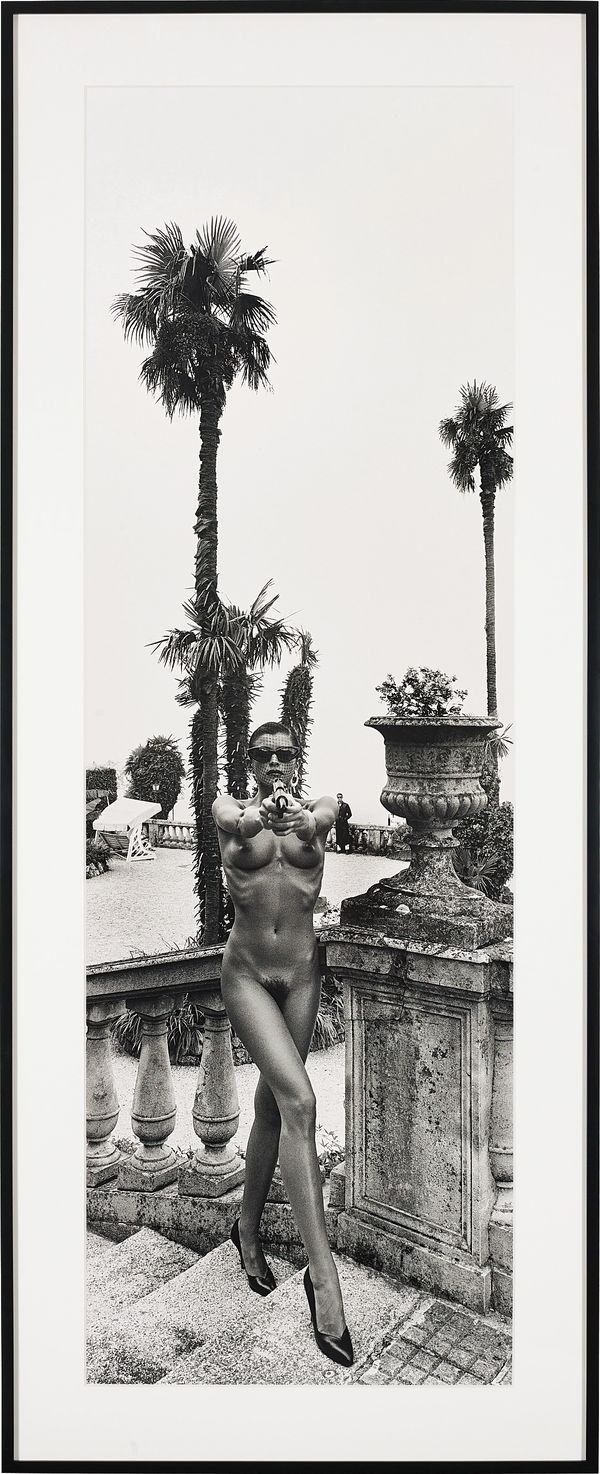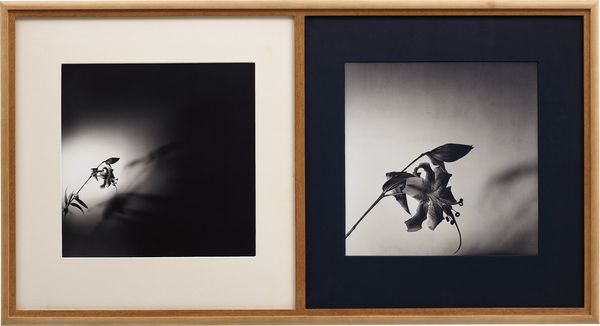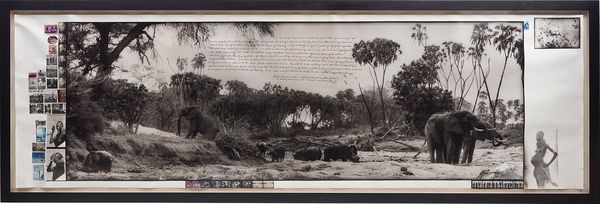Detail from Helmut Newton Panoramic Nude with Gun, Villa d'Este, Como, 1989
In our first-ever Evening edition of ULTIMATE, a tightly curated selection of 27 works range from the late 19th century to the present. Each photograph, carefully selected for its rareness and exclusivity, effortlessly imparts the genius of its creator. Here, we delve further into the artistry and technique of Helmut Newton, Irving Penn, Robert Mapplethorpe and Peter Beard.
Some people's photography is an art. Mine is not. If they happen to be exhibited in a gallery or a museum, that’s fine. But that's not why I do them. I'm a gun for hire.
— Helmut Newton, 2004
Helmut Newton Panoramic Nude with Gun, Villa d'Este, Como, 1989
Provocative and erotically charged, Panoramic Nude with Gun, Villa d'Este, Como exemplifies the quintessential Helmut Newton subject: a powerful nude woman wearing polished heels, lipstick, dark glasses and a net veil over her face, pointing a gun directly at the camera. She commands the space with an alluring and fantastical sensuality while projecting a calmly dominant and elegant air.
This visually arresting image was taken in 1989 during a commissioned shoot for the first calendar published by Max, the glossy Italian monthly magazine. The 1990 Max calendar, featuring 12 models photographed by Newton, included a variant image with the same nude holding the gun down for the month of March. The Max calendar shoot took place at the Hotel Villa d'Este on Lake Como in Italy—here, Newton created his vertical panoramas using a panoramic camera. Four Panoramic Nude images from the 1990 Max calendar, including the image with the gun down, were published and exhibited in 1992 for Archives de Nuit.
My lips were black. I remember using eyebrow pencil on my lips.
— Jean Patchett on her shoot with Irving Penn
Irving Penn Black and White Vogue Cover (Jean Patchett), New York, 1950
The legendary Irving Penn photographed at Vogue for over six decades, during which time he created an unprecedented 165 covers. Black and White Vogue Cover (Jean Patchett) graced the cover of the April 1st issue in 1950 of American Vogue. It was Penn's first cover in black and white and the magazine's first cover since May 1932 to be without color. Vogue's influential Art Director Alexander Liberman called Penn's photographs 'stoppers' for their arresting quality that would stop you in your tracks. This attribute is epitomized in Black and White Vogue Cover, which has undeniably become one of Penn's most enduring images.
At a time when his peers were creating fashion photographs with ornate settings, Penn's minimalist approach was unconventional and distinctive. He replaced indulgent sets with plain backdrops that enabled him to extract the essence of his subjects. Black and White Vogue Cover perfectly exemplifies his emphasis on form, shape and line. Jean Patchett, the subject of this image and one of Penn's favorite models, recalled his brilliance in constructing an entirely monochromatic vision: "My lips were black. I remember using eyebrow pencil on my lips."
I get something out of flowers that other people don't get...I love the pictures of flowers more than I love real flowers.
— Robert Mapplethorpe
Robert Mapplethorpe Double Tiger Lily, 1977
Robert Mapplethorpe: The Perfect Moment, Institute of Contemporary Art, Philadelphia, 1989
In 1977, Robert Mapplethorpe made his first significant impact on the art world with his twin solo shows in New York: Portraits at Holly Solomon Gallery and a selection of male nudes and S&M images at The Kitchen. Later that year, Holly Solomon followed with Flowers, which debuted Double Tiger Lily, 1977, a unique, early masterwork. The total number of works included in the Flowers show is unknown. Aside from Tulips, which has twice appeared at auction, Double Tiger Lily is the only other known work from the show to date. At a time when the art market made clear distinctions between art and photography, Mapplethorpe sought to present his photographs as art with his intricate frames. For him, the frame was not merely the means by which to formally present a photograph but formed a crucial part of his artistic practice.
Mapplethorpe's approach to flowers was similar to the way in which he photographed his human subjects in that he frequently isolated them in the frame, as seen here. Embracing the sexuality of flowers, they became a permanent fixture in Mapplethorpe's oeuvre.
We may be sure that [civilized man] will so disturb the nicely balanced relations of organic and inorganic nature...
— Alfred Russel Wallace
Peter Beard Downwind on the Tiva Lugga, 1965
If Peter Beard's legendary 1965 publication The End of the Game could be condensed into a single work, it would be this monumental composition Downwind on the Tiva Lugga. Taken in 1965, the panoramic photograph features the dry river Tiva in Kenya's Tsavo region. At the time, Beard was working in Tsavo East National Park, where he witnessed and recorded the tragic die-off of elephants — the animal most deeply ingrained within The End of the Game. Yet, contrary to his harrowing images of animal corpses and bones, this seemingly peaceful landscape recaptures 'the life and spirit of a once unspoiled continent'. In this one moment captured by his camera, Africa's wildlife exists in harmony with its natural environment.
Written across the Kenyan sky in Beard's distinctive hand are the words of British naturalist Alfred Russel Wallace (1823-1913): "It seemed sad that, on the one hand, such exquisite creatures should live out their lives, doomed for ages yet to come to hopeless barbarism, while on the other hand, should civilized man ever reach those distant lands and bring moral, intellectual and physical light into the recesses of these virgin forests, we may be sure that he will so disturb the nicely balanced relations of organic and inorganic nature as to cause the disappearance and finally the extinction of these very beings whose wonderful structure and beauty he alone is fitted to appreciate and enjoy" (The Malay Archipelago, 1880).
Beard's appropriation of Wallace's quote provides the narrative to this poignant work — man's unique ability to appreciate and inevitably destroy the wonders of the natural world.
ULTIMATE Evening Sale is on view at 30 Berkeley Square 10-17 May ahead of the 18 May auction.





